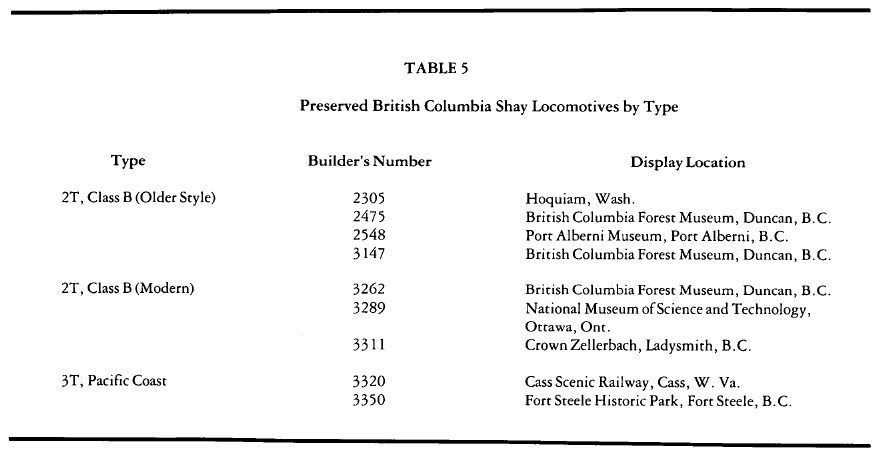Articles
Logging Railroads and Locomotives in British Columbia:
A Background Summary and the Preservation Record
Logging railroads were a widespread and important component of the forest industry in British Columbia from the early 1900s until the mid-1950s. With the replacement of logging railroads by trucking systems, many examples of railroad technology were preserved in a variety of situations in British Columbia and some machines were sold or donated to museums in other parts of North America.
The largest and most prominent of the preserved artifacts are locomotives of a number of types. This paper presents an overview of the characteristics of British Columbia logging railroads and the principal types of locomotives used in logging service. A summary table outlines the number of machines used in British Columbia by manufacturer and then notes all surviving examples. Notes are provided on the provenance and current status of the twenty-four British Columbia locomotives presently preserved in North America. From this summary, the relative significance of the surviving machines for museum display is discussed.
Du début du siècle jusqu'au milieu des années cinquante, le chemin de fer a joué un rôle important dans l'ensemble de l'industrie forestière en Colombie-Britannique. Lorsque le transport ferroviaire du bois fut abandonné au profit du transport routier, de nombreux exemples de technologie ferroviaire furent préservés en Colombie-Britannique et certaines machines furent vendues ou données à des musées en Amérique du Nord.
Les plus imposantes des machines préservées sont certainement les locomotives de divers types. Le présent article expose les principales caractéristiques des chemins defer qui desservaient l"industrie forestière en Colombie-Britannique, ainsi que les principaux types de locomotives utilisés. Un tableau présente le nombre de machines en service en Colombie-Britannique à cette époque, par fabricant, et recense toutes celles qui existent encore. Des remarques indiquent la provenance et la situation actuelle des 24 locomotives de Colombie-Britannique conservées en Amérique du Nord. Se fondant sur ce résumé, l'auteur traite de la.valeur relative des divers spécimens en fonction des exposition des musées.
1 Logging railroad systems were the most significant means of moving timber overland in British Columbia for at least the period 1900 to 1935 and were a highly important component of log transport systems until the mid-1950s.1 By that time most logging railroads had been replaced by more flexible and capital-efficient trucking systems.2 Fortunately, during the 1960s, nearly all steam locomotives surviving from logging service were preserved for exhibition or tourist railroad use in British Columbia and elsewhere in North America.3
2 These preserved locomotives represent the most striking artifacts of the steam logging era and are certainly among the largest. Because of their size and complexity they are also expensive to conserve and display. The purpose of this paper is threefold. Firstly, it provides an overview of the characteristics of logging railroads in British Columbia. Secondly, it focuses on the logging locomotives, considers the sources of supply (i.e., the manufacturers), describes their characteristics, and summarizes the use of each builder's products in British Columbia. Finally, a detailed tabulation summarizes the characteristics and provenance of individual, preserved locomotives from British Columbia operations in order to provide a basis for considerating their significance for museum display and long-term preservation.
I - The Characteristics of Logging Railroads in British Columbia
3 Logging railroads were built for one purpose — to transport timber from the areas where it was cut to a mill or to the nearest water body where the logs could be sorted and rafted to a mill for processing into lumber or related products.4 Reliable operation was essential as large mills could not operate at maximum efficiency without a continuing source of logs.5 The logging railroads were seldom built to carry general freight or passengers and as a result few were operated under government charter. Most were built as temporary systems designed to last only as long as the local timber supply. Consequently, they differed considerably in locational characteristics, construction standards, and equipment from mainline railways such as the Canadian Pacific or Canadian National or even the branch lines of these major railway companies.6
1. Locational and Operating Characteristics of the Lines7
4 Logging railroads generally were built from a fixed terminus such as a mill or log dump into the areas being logged. A line's purpose was to make the timber accessible to logging and to transport the logs at the minimum overall cost to the logging operation while maintaining a reliable timber supply for the mills.8 In specific sites topography was a critical consideration in determining the most efficient plan for logging out a tract of timber and locating a railroad. Because the railroad was built to last for a limited time (i.e., until the timber was removed — which might be for as short a period as one month) and to minimize construction costs, however, curvature, gradients, and road bed could be engineered to lower standards than on mainline, common-carrier railroads.
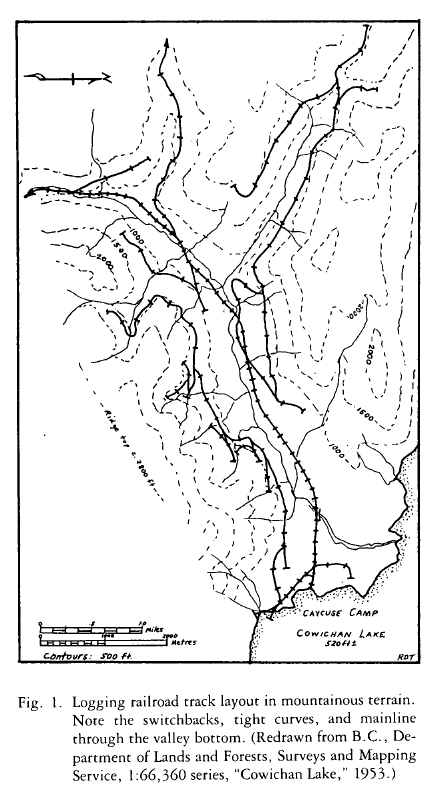 Display large image of Figure 1
Display large image of Figure 15 In general, in the rugged terrain typical of British Columbia, it was most common to enter a timbered area from the lower elevations and build the railroad upgrade into the areas being logged. This permitted hauling the logs down grade to the mills with consequently greater efficiency than hauling loads uphill would have permitted.9
6 The spacing of spur lines was generally determined by the distance yarding equipment could haul logs to the railroad and the obvious, site-specific limitations of topography. Yarding distances varied considerably with the type of equipment available. A small "donkey engine" could yard logs for perhaps only 150 metres while a more sophisticated system of skyline yarding normally could move logs 375 to 500 metres or on occasion as far as 1,075 metres.10 In areas such as the Comox Valley on eastern Vancouver Island where there were no major topographic obstacles to logging, spurs were located approximately 350 to 750 metres apart in areas logged before the mid-1920s.11 As logging progressed through an area, a complex network of temporary spur line trackage developed (see fig. 1). Usually the spur line tracks were removed and the rails re-laid elsewhere as soon as the merchantable timber was removed from the site.12
7 As timber cutting became further removed from the terminal sites a semi-permanent mainline often was developed. Such lines usually ran up the valley bottoms with spur lines radiating into the timbered tributary valleys. Typical patterns of logging railroad location are depicted in figures 1 and 2. Features of track design such as switch-backs and reverse curves to overcome particularly steep topography are noted.
2. Track Construction
8 Nearly all British Columbia logging railroads were built to standard gauge: 4 feet, 8½ inches (1.43 metres).13 This gauge was adopted to facilitate interchange with the branch lines of the major railway systems and also for safety reasons as standard gauge provided greater stability than three-foot gauge or metre gauge used for railroads in other parts of the world. All but three steam-powered operations are known to have used steel rail for track construction.14 In two of the exceptions, operation was on wooden poles in place of rails but both lasted only a short time.15 The capacity of pole railroads or simply "pole roads" was too limited and the system too makeshift to provide reliable, cost-effective operation. The third atypical operation used cut four-inch-by-four-inch timbers in place of rail.16 The weight of steel rail used varied from forty pounds per yard on small operations to seventy pounds on the major systems.
9 In general, the longer a line was to be in place and the more timber to be hauled, the greater the expenditure that could be justified on railroad construction.17 However, a company's existing equipment could dictate minimum standards of construction for a particular section of railway where expediency might suggest lower standards. For example, a large locomotive already on the roster of a company would require a heavy weight of rail and sturdy bridges regardless of whether the timber in a small area would have justified that standard of construction. Projected service life of the rail line also influenced the choice of construction materials and line location priorities. If timber were limited, large expenses to relocate a line to eliminate an adverse grade could not normally be justified.18 On the other hand, an extensive stand of good timber could warrant expensive, high quality railroad construction since the costs could be ammortized over a long period of time.
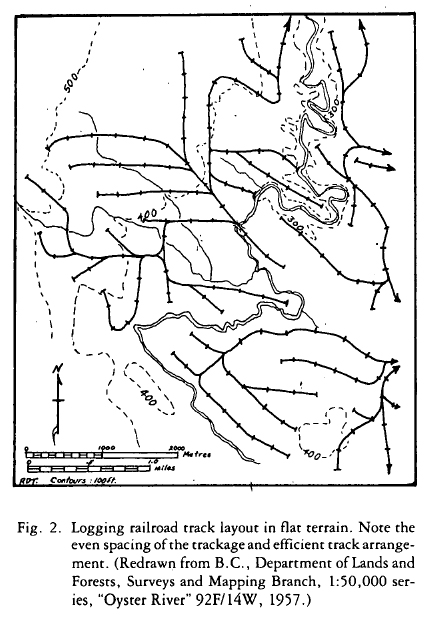 Display large image of Figure 2
Display large image of Figure 210 The maximum grade normally considered acceptable on a major railroad system such as the Canadian Pacific Railway is 2.2 per cent, but on logging lines much steeper gradients were used to reduce construction costs in areas of rough terrain. On spur lines grades of five or six per cent were common while on logging mainlines two- or three-per cent grades were typical.19 In extreme circumstances grades over ten per cent might be constructed when lines were to be in place for a short period — perhaps only a month or two. Steep grades reduced the pulling power of locomotives and also created problems of train control. Stopping a heavily loaded train on a ten-per cent down grade was difficult and required an experienced crew. Such considerations made locomotive maintenance, the use of air brakes, and track maintenance standards particularly important for safety reasons.20
3. Outline of geographic distribution of logging railroads in British Columbia
11 The main concentrations of logging railroads in British Columbia were on Vancouver Island, in the Fraser Valley, along the south-west coast of mainland British Columbia, and in the Kootenays in the south-east part of the province.21 Isolated operations were located on the Queen Charlotte Islands22 and at scattered points throughout the southern half of the province. The greatest activity was on Vancouver Island and the logging railroads were active there for the longest period of time.23 Table 1 summarizes the number of operations in each of the geographic regions noted above.
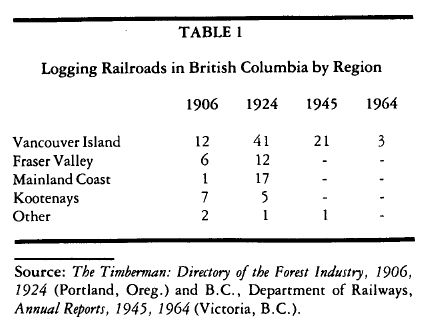 Display large image of Table 1
Display large image of Table 112 The reasons for the differing application of logging railroads in these regions of British Columbia are beyond the scope of this discussion but the following relevant considerations should be noted. The smaller species logged in the southern interior, particularly pine and interior Douglas fir, were more easily moved by trucks and horses than the larger coastal species. In addition, water transport on lakes and rivers such as the Arrow and Kootenay Lakes system was in some instances more feasible than in the areas logged on the coast. Moreover, the topography of many parts of the interior limited the application of railroad technology; only in the large, flat, valley bottoms around Cranbrook and Fernie was it really feasible to use logging railroads extensively. The Fraser Valley and surrounding foothills were logged in part to clear land for agricultural purposes and timber stands were depleted quickly. The supply simply was more limited. On Vancouver Island timber stands were of high quality and closest to major milling and shipping points so logging these areas was economically advantageous. Consequently the best timber was logged first and the remoter stands on the mainland coast were not exploited as rapidly due to their inaccessibility and consequent higher production and transport costs. Topographic conditions also favoured development on Vancouver Island, particularly on the relatively flat coastal plain on the eastern side of the island.
13 In general after 1930 logging railroads were almost exclusively a component of coastal logging operations, most particularly those on Vancouver Island. This is reflected as well in the numbers and the provenance and history of preserved locomotives in British Columbia as noted in part III below.
4. Trends in Operation
14 Summary tabulations and notations in the early logging industry directories and government departmental reports indicate that the logging railroads in British Columbia began as simple operations, seldom more than a few miles in length.24 By the 1920s a number of larger operations had developed using several locomotives and 30 to 50 kilometres of track at any one time. Examples of these larger operations would include the railroads of Comox Logging and Railway Company and of International Timber Company, both on Vancouver Island. As an illustration of the extent of operations in British Columbia during the 1920s, in 1924 74 logging railroads were in operation, using 1,129 kilometres of track and 125 locomotives.
15 The average length of railroad was 15.25 kilometres. Further examination of the operations is revealing. Of the total, 44 operations had only 1 locomotive and each had an average of 6:4 kilometres of track while 15 had 2 locomotives and an average of 15.6 kilometres of track. In sum over 70 per cent of the operations were in this size range and probably these were the operations most readily converted to trucks. Most appear to have been independent operators or small partnerships.25 While the efficiency of the small operations cannot have been great, presumably it was more cost-effective than other means, such as horse logging or trucks, available at that time. It is clear, however, that only modest advances were required in trucking technology before a. conversion to trucks was justified. The balance probably swung in the early to mid-1930s (see table 1), but the details of this transition need further clarification. Also significant was the gradual improvement in public road systems which greatly decreased the costs of truck logging.26
16 The Depression and the Second World War contributed to the retention of logging railroads due to the capital costs of replacement systems such as trucks during the period of low income in the 1930s and the unavailability of new equipment because of wartime production limitations. Moreover, during this period large quantities of used railroad equipment were available at reduced prices.27 Nonetheless, the number of rail lines decreased significantly by the mid-1940s (see table 1) as trucking became increasingly important. In fact, very few new locomotives were built for the logging industry in North America after 1930. The last delivery of a new steam locomotive to a British Columbia logging firm was made in 1940 after a lapse of four years and in total only three were purchased new after 1930.28 The industry continued on for several decades using the equipment at hand or available on the used market.
17 The railroads remained an important part of the larger coastal logging operations until the early 1950s when modernization programmes began. By 1956 the number of rail operations had been reduced to only 6 although 427.33 kilometres of track were in use, for an average length of 71.23 kilometres.29 This was an increase in average length over 1924 of nearly 470 per cent, reflecting the trend toward larger operations with longer timber hauls.
18 The 1950s were a time of corporate consolidation in the forest industry marked by the formation of the present large forest companies such as British Columbia Forest Products and MacMillan Bloedel. Many smaller operations were amalgamated and at the same time the log hauling systems were largely taken over by trucks. By 1960 only three logging railroads were operating in British Columbia; the remainder had been scrapped.30
19 The reasons for the conversion to trucking can be quickly summarized. Firstly, the valley lands where railroads could be built economically were mostly logged off and the costs of rail line construction and operation on the steeper hillsides were excessive. Larger trucks with improved brakes and with greater capacity than vehicles of the pre-Second World War years were available and could be used on roads built at a much lower cost than a railroad. In general, trucking systems were more flexible and required less capital to operate because they did not need a fixed railroad to run on. Depending on the circumstances, particularly the relative length of haul, there were also savings in labour. By the late 1940s it was noted that "motor truck installation and operating costs are lower than railroads and therefore, have been widely introduced and successfully used."31 In a few situations, however, where haulage distances were great, railroads could still be competitive and it was under these circumstances that a few logging railroads survived. They operated in conjunction with trucks which acted as feeders to the railroad. In effect the trucks replaced the spur line railroad operations. On the surviving railroads, unit trains of logs were run from centralized reloading sites. Trucks brought the logs from where they were cut to terminal sorting grounds and from there the logs were trans-shipped by rail to the mills. By the 1970s only two such rail operations remained, one used by Canadian Forest Products on northern Vancouver Island and the other by Crown Zellerbach Canada on southern Vancouver Island. Both railroads, still operational, are fully dieselized, with modern equipment.32
20 In summary, the logging railroads were temporary, one-commodity operations, built to move timber from the cutting areas to the mills. They operated in rough terrain which often required steeply graded track with sharp curvature. Often the trackage was in place for only a short time and the standards of construction were lower than on major railway systems. Efficient, low-cost operation dictated these characteristics. However, logging railroads of this type were only possible by the availability of specialized technology — locomotives and to a much lesser degree rolling stock [The characteristics of logging railroad rolling stock are outlined briefly in the appendix.] — that could be employed effectively under these severe service conditions
II - Logging Railroad Locomotives Used in British Columbia
1. Types of Locomotives
21 The locomotive was by far the most costly and significant piece of equipment used on the logging railroads. There were two basic types of logging locomotive- rod locomotives and geared locomotives - and four major manufacturers supplying locomotives to the specialized market in North America.33 The rod locomotive was essentially the same type of machine used on the mainline railroad systems, but modified to be better suited to logging conditions.34 In these machines the driving wheels were mounted in a rigid or sometimes articulated frame beneath the boiler and the wheels were connected to the cylinders by driving rods. Adaptations for logging service normally included the addition of pilot and trailing wheels to improve safe operation in both directions (turning facilities were seldom available on logging lines) and of small-diameter driving wheels to increase tractive effort or pulling power. A typical example of a rod locomotive is shown in figure 3. Some machines were equipped with side or saddle tanks. These normally carried extra water for the boiler. Carrying the water in this way added to the weight on the locomotive's driving wheels and hence increased traction. Rod locomotives used on British Columbia logging railroads varied in size from small, 10-ton, 0-6-0 types to articulated 2-6-6-2 machines exceeding 150 tons in weight.35 The most typical wheel arrangements were the 2-6-2 and 2-8-2 types. The dominant manufacturer of this type of logging locomotive in North America appears to have been the Baldwin Locomotive Works36 in Philadelphia, Pennsylvania, whose products were used on a number of logging railroads in British Columbia (see table 2). Other less significant manufacturers of rod locomotives were the H.K. Porter Company of Pittsburg, Pennsylvania, American Locomotive Company (Alco) of Schenectady, New York, Montreal Locomotive Works (MLW) of Montreal, Canadian Locomotive Company (CLC) of Kingston, Ontario, and Davenport Locomotive Company of Davenport, Iowa.
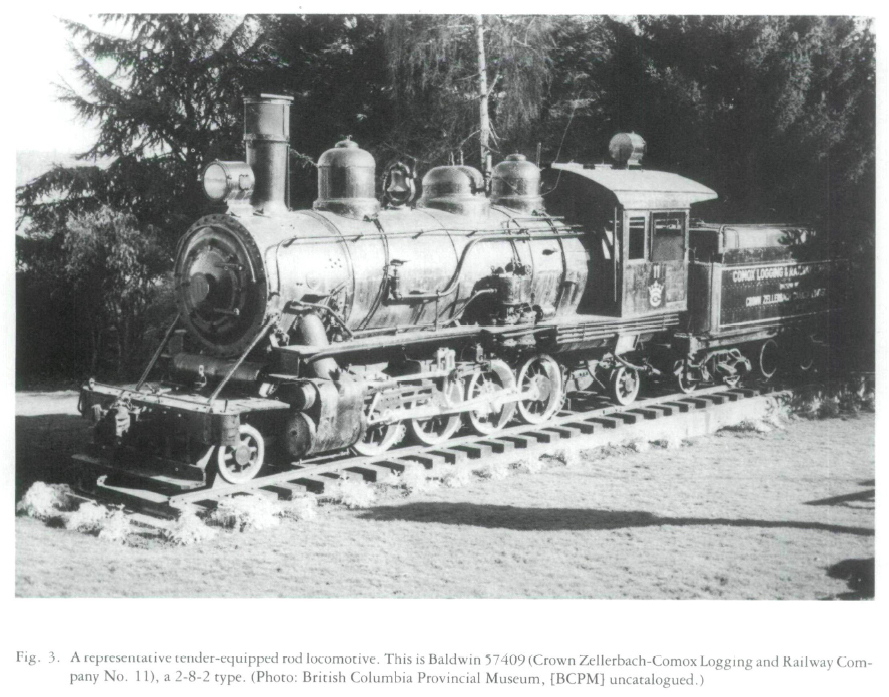 Display large image of Figure 3
Display large image of Figure 3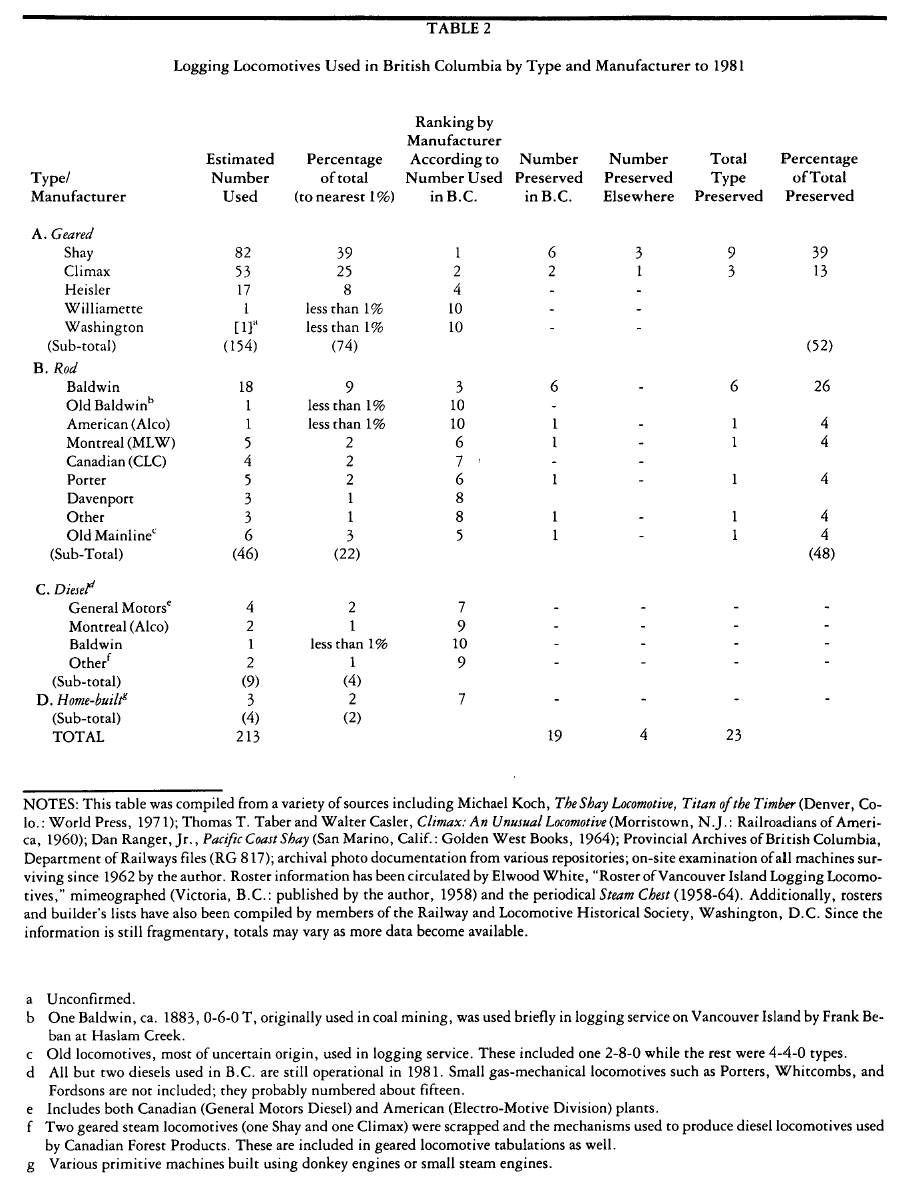 Display large image of Table 2
Display large image of Table 222 The second basic type of logging locomotive was the geared engine.37 Several differing designs were developed for the logging industry in the United States and were used in British Columbia. The geared locomotive was designed particularly to operate on steep grades and around sharp curves. In consequence, these locomotives were well adapted to conditions in British Columbia. The principle of all designs was to have the power from the locomotive's cylinders transmitted to the driving wheels by a system of gears and articulated drive shafts which produced low speed but high power operation in much the same manner as an automobile permanently in low gear.
23 The driving wheels were mounted in two axle trucks which could move independently instead of in a semi-rigid frame as used on rod locomotives. As a result, these were highly adaptable to typical logging railroad track-age. Whereas the rigid wheel base of a typical rod locomotive might be 4.27 metres, the rigid wheel base of a geared locomotive might be only 1.32 metres. As a result, the latter could operate on curves of much tighter radius. The performance and other characteristics of a Baldwin rod locomotive and a comparable geared locomotive, a Shay, are shown in table 3. The ability of the geared locomotive to perform better than the rod engine on steep grades is readily apparent from this comparison.
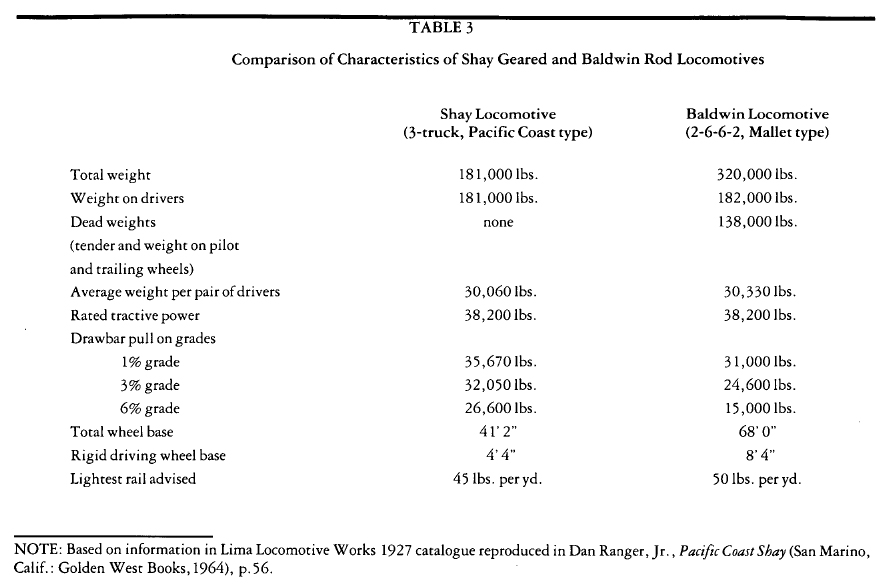 Display large image of Table 3
Display large image of Table 324 There were three principal types of geared locomotives used in North America. These were the Shay, built by the Lima Locomotive Works of Lima, Ohio, the Climax, built by the Climax Manufacturing Company of Corry, Pennsylvania, and the Heisler, built by the Heisler Company of Erie, Pennsylvania.38 While all were similar, there were important differences in design. The Shay was developed first, being built in quantity by the 1880s. In typical form, it featured a boiler offset to the left side of the locomotive frame with two, or most commonly three, vertically mounted cylinders driving an articulated crank shaft running along the right side of the locomotive. Shays ranged in size from 2-truck machines of less than 10 tons to 3- and 4-truck locomotives exceeding 150 tons. Over 2,700 were built before production ceased in 1945. Locomotives in the 50- to 90-ton range were most common.39 A typical Shay is shown in figure 4.
25 The typical Climax differed in having its boiler centered on the longitudinal axis of the locomotive and having one cylinder on each side. The cylinders drove, through a gear box, an articulated drive shaft running under the boiler. The shaft was geared to each axle of each truck under the locomotive. A representative Climax is depicted in figure 5. Climax ranked second to Shay in the total number manufactured. Between 1,030 and 1,060 were produced before the plant closed in 1928.40
26 The Heisler also had two cylinders and a centrally mounted boiler but its cylinders were arranged in a V pattern, forming a cradle-like configuration under the boiler. The drive shaft was geared to only one axle of each truck with power to the other being transmitted by conventional driving rods.41
27 Shay, Heisler, and Climax locomotives were all developed for the same market and were all competitive. Each incorporated new technology in the basic design as developments took place. However, consideration had to be given to ease of maintenance and rugged design as few logging railroads had extensive maintenance facilities.42 The most advanced examples of the geared locomotives were developed in the 1920s for the west coast logging railroads. The most advanced, mass-produced Shay was called the "Pacific Coast" Shay, while the Heisler equivalent was the "West Coast Special." Climax did not specially name its product but it had equivalent features. These were modern locomotives for the period, featuring piston valves, girder frames, superheaters, and other advances found in mainline railroad locomotives. However, the Depression effectively ended orders for new logging locomotives and only the Pacific Coast Shay was produced in quantity. It is notable that of a total of twenty-four Pacific Coast Shays built between 1927, when the design was introduced, and 1940, when production ceased, seventeen operated in British Columbia. The design clearly was considered a success by operators.43 In contrast, only one West Coast Special Heisler and two or three equivalent Climax locomotives were used in the province.
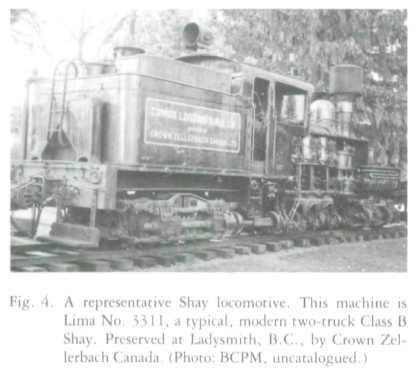 Display large image of Figure 4
Display large image of Figure 42. Comparison of the Use of Different Logging Locomotives in British Columbia
28 The four major manufacturers — Baldwin, Lima, Climax, and Heisler — all successfully marketed their locomotives in British Columbia. Table 2 provides a summary of new and second-hand locomotives, by builder and type, operated in the province. Note that locomotives of other manufacturers were also used but in limited numbers. A ranking of the different manufacturers clearly establishes Lima's Shay locomotive as the most commonly used machine with thirty-nine per cent of the total number of logging locomotives used. Climax ranks second with twenty-five per cent, Baldwin rod locomotives are third at nine per cent, and Heisler fourth at eight per cent. Other manufacturers' contribution to the total roster of logging locomotives is minor.
29 Perhaps of greatest significance is the cumulative total of Shay, Heisler, and Climax products (154 machines) which account for 74 percent of all logging locomotives in the province. Clearly, geared locomotives were the dominant form of motive power on the logging railroads in British Columbia and competition was not between geared locomotives and rod locomotives but rather among the different types of geared engines. The comparative ratio between the different types used corresponds approximately with total sales of the three types throughout North America.44
30 The other noteworthy category in this tabulation is "Old Mainline." These machines ranked fifth in usage in the province. Most were obsolete locomotives acquired from railroads such as the Northern Pacific, Canadian Pacific, and Pennsylvania, and used in logging service with very little modification. Five of six identified were of the 4-4-0 or "American Standard" wheel arrangement.45 Locomotives of this type would have been poorly adapted to logging service due to their large driving wheels and were used, as far as can be determined, only in the early years of the industry and in areas of relatively flat terrain.
31 In-service comparisons between the different types of locomotives to determine which was best in logging service are now impossible and it appears that few, if any, comparisons were made in earlier years under operational conditions.46 Documentary evidence also appears to be lacking and in the absence of such information it is reasonable to assume from the sales figures that overall the Shay was the best machine for conditions found on the west coast. The Shay was a powerful and comparatively smooth-riding machine that was easily serviced due to the accessible arrangement of its drive train. The Climax and Heisler were generally conceded to be more difficult to service and the Climax was a rough riding locomotive, hard on the crews.47
32 The availability of different types of locomotives gave logging railroad operators considerable choice and flexibility in acquiring equipmenr to develop efficient log-hauling systems. Small scale operations typically had one or two geared locomotives in the fifty-ton range which could be used in most situations. Larger operations could afford to specialize and might purchase a rod locomotive for mainline hauling over the more permanent sections of railroad where this type of machine's greater speed was advantageous. Normally these larger systems then employed geared locomotives on the spur lines to feed carloads of logs to the mainline.48 In the 1950s when trucks were used increasingly to replace the spur lines of the logging railroads, the geared locomotives were retired first as they were not as well suited to line haul situations because of their characteristic low speed. This evolution is significant both for historical interest and also because it helped determine the types of locomotives that would be preserved in the 1960s.
33 It is also evident from table 2 that the use of diesel locomotives on the logging railroads has been very limited. In total, the nine known units represent only four per cent of the total of logging locomotives used in the province. Only two operations acquired diesels and both companies continue to operate logging railroads in 1981.49 Other companies scrapped their railroad operations entirely rather than acquire new diesel power for their established systems.50 The cost-effectiveness of dieselization would have depended on a number of considerations including the cost of maintenance of the rest of the railroad's physical plant, the location and value of timber, the length of haul, and the costs of acquiring and operating additional trucks.
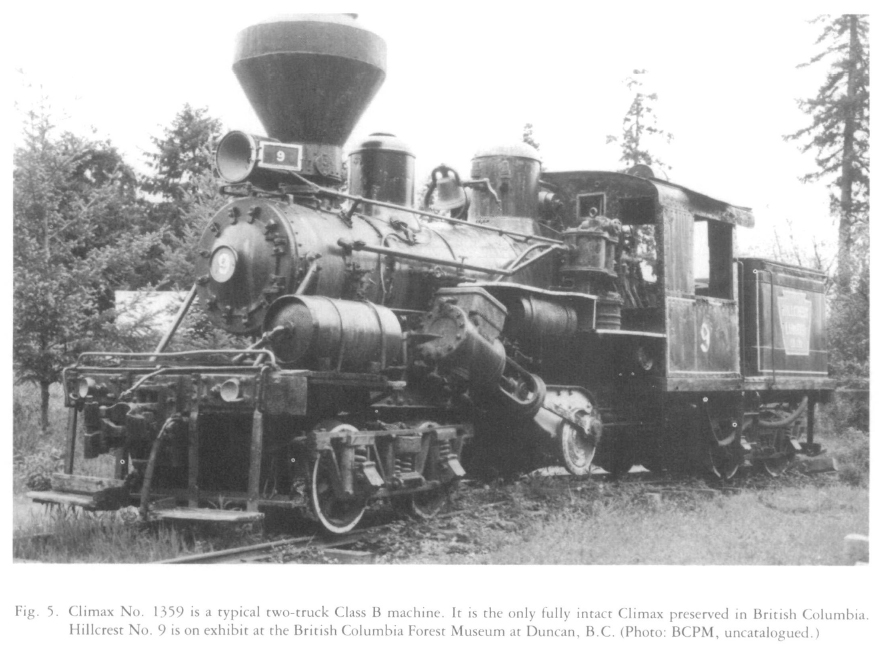 Display large image of Figure 5
Display large image of Figure 534 The limited number of Canadian-built locomotives used in British Columbia is also noteworthy. No geared locomotives, other than home-built ones, were manufactured in Canada for use in British Columbia. Of rod locomotives, only nine of forty-six were Canadian-built. The reason for this lack of sales from Canadian manufacturers awaits further study but a significant factor may have been the relatively small Canadian market for logging locomotives compared to the large market in the western United States. American builders were probably able to develop specialized designs at lower cost for the logging railroads. To illustrate, in 1928 there were 352 rod locomotives and 880 geared locomotives operating in eight western states and British Columbia. Of these, only 24 rod and 113 geared locomotives were used in British Columbia.51 Since the geared locomotives were built to patented designs and there was little need for more variations of the concept, the remaining market was small indeed. Most of the Canadian products can be described as small industrial locomotives that could have been used in a variety of industrial situations rather than under specialized logging conditions. Why Shays were not built in Canada under licence is unclear but again the market may have been too small to justify the cost of setting up the facilities for production at a time when Lima itself was not always working at capacity.52 Probably there was no real advantage to the company.
Ⅲ - Preserved British Columbia Logging Locomotives
35 As noted in table 2, 24 British Columbia logging locomotives survive out of a total of approximately 213 operated in the province. Of the 24, 21 are still in British Columbia and all have been dedicated to some form of public or private preservation. All other steam locomotives have been scrapped or are beyond salvage. Table 4 provides a detailed summary of all the surviving steam locomotives from British Columbia logging service, noting their principal characteristics and details of ownership.
36 The Shay locomotive, which comprised nearly forty per cent of all British Columbia logging locomotives, is well represented with nine machines preserved, six within the province itself, although, when individual machines are examined, there is considerable duplication. Preserved Shays represent thirty-eight per cent of all preserved logging locomotives in the province so the number preserved corresponds closely to the number originally in use. Table 5 records, by builder's number, the surviving Shays, grouped to define essentially identical machines.
37 There is some variation in size and construction detail within the older style Class B Shays and, similarly, within the modern Class B Shays, but in technological terms the machines are essentially similar and represent the same stages of Shay development. The two Pacific Coast Shays are identical. Before definitive conclusions could be drawn regarding the representativeness or uniqueness of each machine, a detailed study of all the Shays used would be required. However, it is clear from preliminary surveys that the preserved Shays are essentially representative of the typical machines used in British Columbia. It is safe to say that from a national perspective Lima's 3289, preserved at the National Museum of Science and Technology is an entirely appropriate example of a west coast logging locomotive. Overall, the Shay has been well-represented and three or four of the surviving machines are in operational condition. Parenthetically, while operation may not represent the purest form of artifact conservation, in a practical sense it has seemed to ensure greater care being given to the machines. All locomotives on static exhibit have suffered considerably from weather and vandalism.
38 Three Climax locomotives from British Columbia have been preserved but of these only one is essentially complete and preserved in Canada. For many years engine 1057 now at the British Columbia Forest Museum, was abandoned in the forest and many parts were removed or damaged. Only the boiler, frame, and part of the drive train are original. Consequently its value as a representative machine is diminished. Engine 1693 is now in Washington State and after a decade of neglect has undergone reconstruction for tourist railroad use. The British Columbia Forest Museum's other Climax, 1359, a representative two-truck, Class B machine, is the only known intact Climax locomotive in Canada.53 Since Climaxes were the second most common type of logging locomotive in the province, the value of this machine as an artifact is most significant and its conservation should be a priority. No Heislers or examples of other geared locomotives were preserved so these gaps must remain in historical collections. The omission of a Heisler from the list of preserved British Columbia locomotives is sad indeed for it was the fourth most common type of locomotive in the province. Private efforts were made to save the last Heisler, but by the time the would-be purchaser was aware of the machine's availability it had already been sold for scrap.54
39 Rod locomotives, most notably Baldwins, have been preserved in some quantity. In total, rod locomotives represent nearly one-half the total number of preserved locomotives yet only twenty-two per cent of logging locomotives in the province were of this type. This high proportion of preserved locomotives was due, as noted, to the fact that as trucks progressively took over from the railroads, it was the geared locomotives that were scrapped first. They had been used in the steep spur lines which were the most expensive to operate. Rod locomotives, normally used on the longer mainline logging railroads, were retained because, on the established lines, they were cost-effective to operate.55 Of the twelve rod locomotives preserved, ten came from the last three operating logging railroads (i.e., four from MacMillan Bloedel, four from Crown Zellerbach, and two from Canadian Forest Products). These three companies had retained the locomotives until the 1960s or 1970s when historical interest had become sufficient to ensure their preservation in some form.
40 The remaining two preserved rod locomotives — the Baldwin 2660 in Winnipeg and the Marschuetts and Cantrell "Old Curly" in Burnaby-were preserved well before any of the other machines because of their connection with the construction of the Canadian Pacific Railway rather than their representativeness as logging locomotives. However, the significance of "Old Curly" as a logging locomotive is also great because it is typical of perhaps twelve to fifteen small rod locomotives used in the province in the period 1890-1920. It is the only survivor of this particular type of small tank locomotive used on the more technologically primitive lines.56
41 While the range of equipment, defined by size, builder, and wheel arrangement, represented by these twelve rod locomotives is great, for all but the two Canadian Pacific Railway locomotives a simple grouping is possible. There are basically two types preserved: tank engines and tender-equipped engines. Of the former, six are preserved, of the latter, four. Consequently, there is considerable duplication in the types preserved. As with the geared locomotives there is great variation in the state of preservation of these machines. Only one is operational (Montreal 65337) and it was superficially altered for service on the Btitish Columbia Museum Train. Only Baldwin 60942 is stored under cover in fully intact condition.57 It was moved into storage after being retired from service by MacMillan Bloedel in 1973- All the other rod locomotives are on outside exhibit, exposed to the weather and vandals. Alco 61859 is undoubtedly the best maintained of this group due to the remoteness of its display location on northern Vancouver Island and the interest that Canadian Forest Products staff have taken in the machine. However, the majority of preserved locomotives on static outdoor exhibit receive only cursory maintenance and deteriorate rapidly to what might best be termed hulk condition with all small or breakable parts missing.58
42 The record of logging locomotive preservation in British Columbia has been significant with twenty-four preserved machines representing a number of types. However, because of the essentially random and unco-ordinated nature of the preservation attempts, there is considerable duplication, some significant gaps - notably the lack of any Heislers —and some poorly represented types. Since the record cannot be re-written, gaps filled, or oversights corrected, the relative significance of the different types of locomotives can suggest priorities for conservation and restoration efforts. Specifically, the British Columbia Forest Museum's former Hillcrest No. 9 (Climax 1359), as the only surviving intact Climax in Canada, should receive particular care and attention. The other machine of unusual interest is "Old Curly," both because of its early history and since it represents a small, turn-of-the-century, logging locomotive. Fortunately, several of the other significant machines - a Pacific Coast Shay and three Class B Shays - are in good repair. Only three or four of the rod locomotives are in good condition and of these only one has been under cover since being withdrawn from service. This machine, Baldwin 60942, provides the best remaining opportunity for simple conservation of an engine in operational condition. All other locomotives would require extensive repairs and restoration to bring them to a reasonable state of preservation ot maintenance.
43 Overall, the record is laudable and many machines were saved. In fact nearly all steam logging locomotives surviving after the early 1960s were preserved. Preservation efforts were often unco-ordinated, however, and some important machines were missed. Certainly there was no systematic effort to select and preserve machines other than the private efforts of Gerald Wellburn, founder of the British Columbia Forest Museum, whose work is evident in the collections now on display at Duncan. Corporate interest by both the Hillcrest Lumber Company and Comox Logging and Railway Company was also important. Interest by government bodies did not occur until the late 1960s or early 1970s when the surviving MacMillan Bloedel engines were acquired by the province.
44 As other forms of industrial technology become obsolete, responsible historical institutions will be faced with hard choices about which, if any, artifacts are to be preserved. These choices should be based on well-reasoned criteria applicable to each industry and which define such considerations as representativeness, the history of the artifacts, technological features, important technological changes and innovations, and the significance of the artifact to the overall history of the industry, or at least a component of the industry. However, once technology is obsolete it may already be too late to define these criteria adequately so that the answers may in fact lie in a careful monitoring of industrial change as much as in historical analysis. Had the basis been laid in the early 1950s for a programme of logging locomotive preservation based on a study of the types used in the province, perhaps a more representative, historically more interesting collection of logging locomotives would have been preserved in British Columbia. Retrospectively, such an analysis has provided an indication of significance for restoration, conservation, and interpretation of the surviving artifacts. Additionally, such information is applicable to museum exhibits on the industry by suggesting which types of equipment should be represented in illustrations, models, and graphics, and as background for exhibit interpretative information.
APPENDIX Logging Railroad Rolling Stock
45 Because the logging railroads were built to carry a single commodity, logs, the types of rolling stock were limited. There were also three basic types of log cars as well as a very limited amount of special equipment such as snow plows and speeders (crew cars).
46 The first and most primitive type of log car was the disconnect truck. These were operated in pairs and were basically freight car trucks with a bolster across them to support the logs. They could be coupled together when empty but when loaded were moved apart a sufficient distance to support the ends of the logs being carried. Their main drawback was that they could not be readily fitted with air brakes. These were seldom used after the 1920s in British Columbia and as far as can be determined none has been preserved in the province.
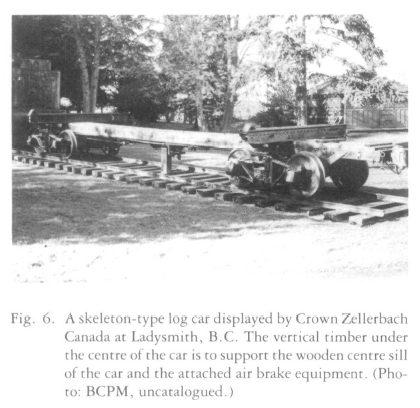 Display large image of Figure 6
Display large image of Figure 647 The second and apparently most common log car was the so-called skeleton car. It had a basic frame built between two freight car trucks, an arrangement which permitted air brakes to be applied while maintaining its light weight and easy maintenance (see fig. 6). The third type was the more-or-less standard railroad flatcar equipped with log bunks. Drawbacks of these cars were their greater weights, higher cost, and the tendency of the cars to accumulate bark and other debris on the deck, adding non-productive weight.
48 There was also specialty equipment used for moving heavy machinery, for trade maintenance, firefighting, and for carrying the loggers themselves. These were basically standard railroad equipment modified to suit the needs of individual companies. The general references noted in the paper all include summary descriptions and illustrations of the more common types of logging railroad equipment.

